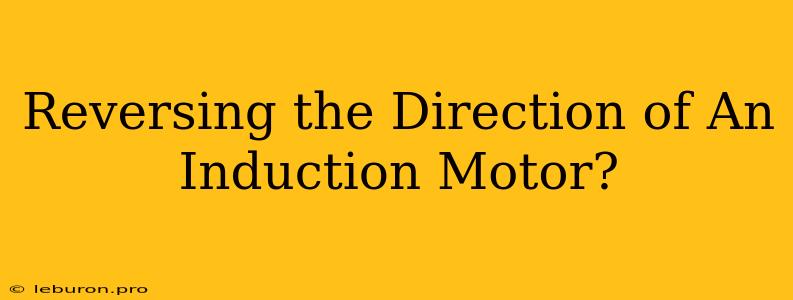Reversing the Direction of an Induction Motor: A Comprehensive Guide
Induction motors are ubiquitous in industrial and domestic applications due to their robust construction, efficiency, and ease of maintenance. One crucial aspect of motor control is the ability to reverse its direction of rotation. This capability is essential for various applications, such as conveyors, pumps, and fans, where the direction of flow or movement needs to be adjusted. This article delves into the mechanisms behind reversing the direction of an induction motor, exploring the practical methods, considerations, and applications.
Understanding Induction Motor Operation
Before exploring the reversal process, it is crucial to understand the fundamental principles behind induction motor operation. The motor comprises a stator (stationary part) and a rotor (rotating part). The stator houses windings that carry alternating current (AC) and create a rotating magnetic field. This magnetic field induces a current within the rotor, creating its own magnetic field. The interaction between these magnetic fields generates a torque, causing the rotor to rotate.
The Role of Magnetic Fields in Rotation
The direction of rotation is directly determined by the sequence in which the stator windings are energized. By altering this sequence, the rotating magnetic field's direction can be reversed, effectively reversing the motor's rotation.
Methods for Reversing Motor Direction
There are primarily two methods for reversing the direction of an induction motor:
1. Phase Sequence Reversal
This method involves switching the connections of any two phases of the stator windings. This changes the sequence in which the phases are energized, effectively reversing the rotating magnetic field and thus the motor's direction.
Example: Consider a three-phase motor with phases labeled A, B, and C. To reverse the direction, you can switch the connections of phases B and C, while keeping phase A unchanged. This alters the sequence of energization from A-B-C to A-C-B, resulting in a reversed rotation.
Implementation: This method is typically implemented using a motor control circuit with contactors or relays. The switching operation can be manually triggered or automatically controlled through a programmable logic controller (PLC).
2. Using a Direction-Control Relay
Another method involves utilizing a direction-control relay, also known as a reversing relay. This type of relay contains two sets of contacts that switch simultaneously, allowing for the phase sequence change required for motor reversal.
Advantages:
- Simplified Wiring: The relay provides a more streamlined approach, reducing the complexity of wiring compared to directly switching individual phase connections.
- Enhanced Safety: By managing the switching through a single unit, the relay helps ensure that the motor is adequately protected from potential short circuits or damage during the reversal process.
Applications:
This method is widely used in industrial settings where reliable and efficient motor reversal is critical, such as in conveyor systems and crane operations.
Factors to Consider for Reversing an Induction Motor
While the principles of motor reversal are straightforward, certain factors should be considered for proper and safe implementation:
1. Load Type and Inertia
The type and inertia of the load connected to the motor can significantly impact the reversal process. High-inertia loads may require special considerations, such as gradual acceleration and deceleration to prevent motor damage.
2. Braking Mechanisms
In some applications, it might be necessary to implement braking mechanisms to quickly stop the motor during the reversal process. This is especially important in scenarios where the motor operates at high speeds or when a rapid change in direction is required.
3. Motor Rating and Control Circuit Capacity
It is vital to ensure that the motor and its control circuit are adequately rated to handle the reversing operation. The control circuit should be designed to withstand the current surges that may occur during the reversal process.
4. Safety Considerations
- Electrical Safety: Implement proper electrical safety precautions to prevent accidental contact with energized components and potential electric shock.
- Mechanical Safety: Ensure that all mechanical components are properly secured and protected from hazards during the reversal process.
- Operating Environment: Consider the surrounding environment and ensure that the motor is protected from hazardous conditions such as dust, moisture, or extreme temperatures.
Applications of Motor Reversal
Motor reversal finds widespread application in various industries and sectors, enabling essential functionality in diverse equipment.
Common Examples:
- Conveyor Systems: Reversing the direction of a conveyor belt allows for bidirectional movement, transporting materials in both directions.
- Pumps: Pump reversal is essential in applications where flow needs to be controlled, such as in water circulation systems and industrial processes.
- Fans: Reversing the direction of a fan can be used for ventilation, cooling, or dust extraction systems.
- Cranes and Hoists: Reversing the motor allows the crane to lift and lower loads or move them horizontally.
- Machine Tools: Motor reversal is crucial in machine tools for operations such as cutting, drilling, and milling.
Conclusion
Reversing the direction of an induction motor is a fundamental aspect of motor control, enabling flexible and versatile operation in various applications. Understanding the principles, methods, and considerations involved in motor reversal is crucial for ensuring safe, efficient, and reliable operation. By employing appropriate methods and considering the specific application requirements, motor reversal can be effectively implemented, enabling seamless direction changes and enhanced functionality in diverse equipment.
